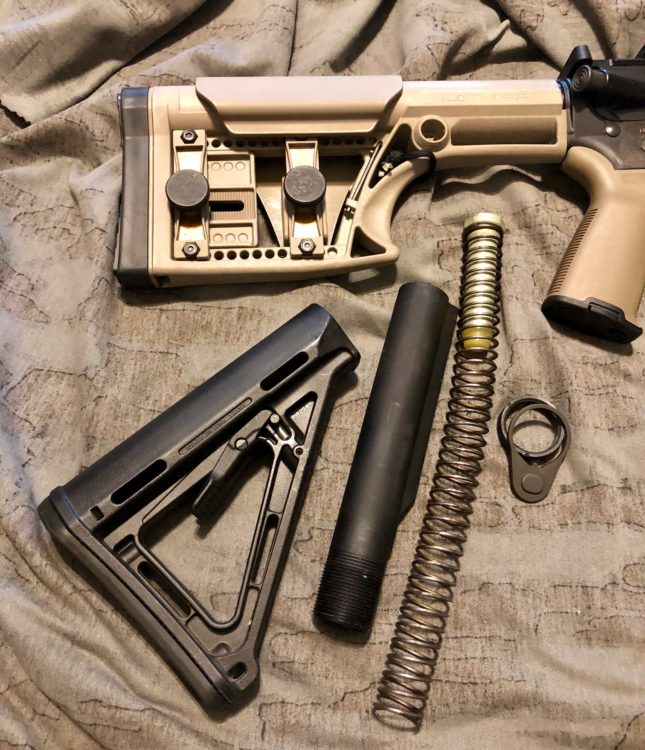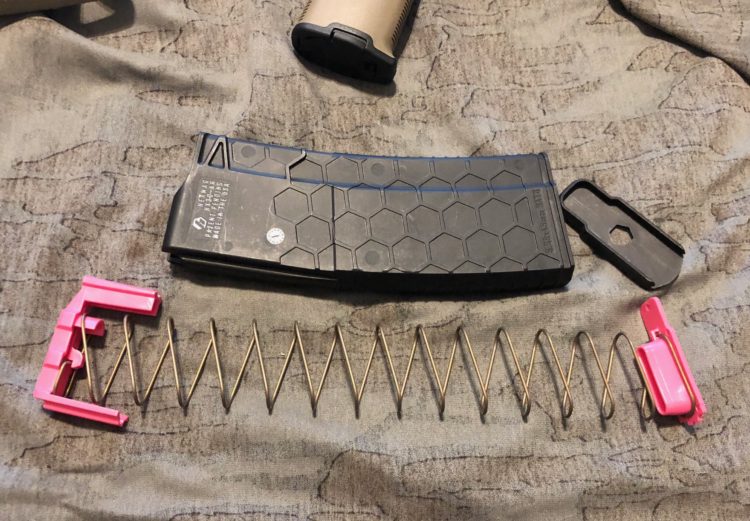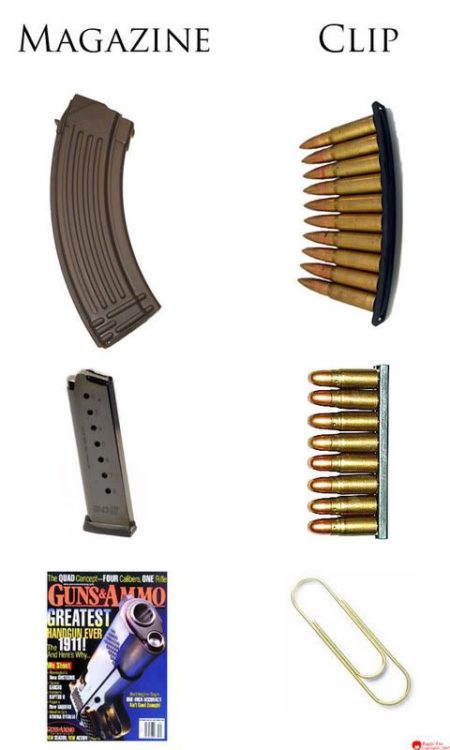The Doctor will school you now.
From Dr. LateBloomer
The “AR-15” is the common name for a style of semi-automatic rifle which is perhaps the most misunderstood firearm in modern history. To listen to gun controllers, one would think that this style of firearm had emerged from the depths of hell, become sentient, and started attacking residential subdivisions across the country. I am here to attempt to explain in layman’s terms what this firearm is, why it is so popular, and to dispel ignorance and myths about this useful rifle design.
The main caveat is that I am doctor not a gunsmith. I am merely an owner and enthusiast of this style of rifle. I have shot my own versions many times for recreation and in competition. I have torn down and reassembled them myself on many occasions. I should also note that my particular rifles spend their evenings locked up in my safe to prevent them from escaping and terrorizing the neighborhood at night. Which is more than I can say for several neighborhood dogs.
Semi-automatic
The “AR” is NOT, repeat NOT a “weapon of war”. Why? Current military rifles are select-fire – the gun fires a burst or continues to fire as long as the trigger remains depressed until all the ammunition is gone. There are already restrictions in place on fully automatic firearms, and there have been since 1934.
The AR-15 is a SEMI-automatic rifle – one pull of the trigger results in one shot fired. That’s all. It is NOT a “military” weapon. Semi-automatic firearms have been around for well over 100 years. There is nothing new or insidious about the mechanics of semi-automatic firearms. People have used them for generations, and it is the dominant style of firearm in current use.
Origins
The AR in AR-15 stands for “ArmaLite Rifle” – which is the name of the company which came up with the original design in the late 1950’s. Armalite subsequently sold the rights to Colt, which went on to manufacture the full-auto military version. “AR-15” has become the popular generic name for the style of rifle, but the AR does NOT stand for “assault rifle”, and average citizens may only purchase semi-automatic versions. Here is a timeline for those who may be interested. https://www.ammoland.com/2016/04/ar-15-rifle-historical-time-line/#axzz57hEpGDub
Modularity
The reason for the popularity of this style of rifle is its modularity. Parts can be swapped out for different versions with relative ease. That means that the average gun owner (or pediatrician) can make his or her own cosmetic modifications without paying a gunsmith to do the work. The problem is that those cosmetic modifications are widely misunderstood by the non-gun owning public. Many people (including lawmakers) who are ignorant about how firearms actually work, assume that those cosmetic features somehow make the rifle more “deadly”, when in reality, nothing could be further from the truth. None of the features that “define” an AR in the public’s imagination change the way the firearm functions. The internal mechanics remain the same as any other semi-automatic firearm. An analogy would be to say that just because you’ve added racing stripes to a car’s paint job, and hung fuzzy dice from the rear view, doesn’t mean that you’ve done anything to actually make the car go faster.
Flexibility
One of the advantages to modularity is that the AR is easy to disassemble. It is composed of two main parts – the upper receiver and the lower receiver – which separate by pushing two pins. The reason this is advantageous is that many uppers and many lowers are interchangeable, allowing flexibility for different uses. For instance, I have a whole separate upper receiver designed for a slightly different caliber ammo, so that I can use the gun for hunting large game. I just pop one upper off, and pop the other upper on, and I’m ready to transition from target matches to deer season. Additionally, I have a bolt adapter (an internal part that slides into the gun) which allows me to shoot an even smaller caliber of ammo for steel target matches. Thus, my particular AR – with the right parts – allows me to shoot three different calibers of ammo for three different types of shooting, without having to own three separate rifles.
I’ll now attempt to explain some of the cosmetic features, and why they make for a popular and useful rifle.
Adjustable stock
The adjustable stock was one of the features singled out during the failed “Assault Weapons Ban” of the 1990’s. This feature simply allows the firearm stock length to be adjusted to fit different size users. In other words – it can be made comfortable for the arm reach of a small-to-average size woman like myself. Without an adjustable stock, I would be forced to find (and pay) a gunsmith to saw off and reshape a solid stock to fit me. Because of the AR’s modularity, I was even able to perform a swap-out of one style of adjustable stock for another – all by myself. Banning adjustable stocks sounds a bit silly and even sexist now, doesn’t it?
Pistol grip

This feature was also on the banned list. There is nothing nefarious about a pistol grip. It is simply a chunk of rubber or plastic which allows the user to keep a firmer hold on the firearm. Maintaining better physical control of a firearm sounds like a safety feature to me, not something “dangerous”. I have personal experience in swapping out the pistol grip on my rifle for one of a different color (an operation performed at my kitchen table), and I can confirm that this piece of hollow plastic isn’t any more “dangerous” than a doggie chew toy.
Barrel shroud
This is yet another feature that was on the banned list. Though the word “shroud” certainly sounds menacing, another name for this component is “hand guard”. The purpose of this feature is to keep the user from burning their hands on a hot barrel, because firing a gun generates heat. There is nothing dangerous or evil about keeping someone from burning their hands. In a traditional style rifle, wood serves that purpose. Modern hand guards are now available in a variety of colors, designs, and materials for those who like to personalize their firearms. (like myself)
Flash hider
This is another previously banned piece of metal. Its only purpose is to reduce the amount of flare/flash that comes out of the end of the gun when it is fired. That flash can sometimes interfere with the shooter’s vision in lower light conditions. I consider this one to be a safety feature as well, as you never want a shooter’s vision to be obscured. It in no way makes the firearm more “dangerous”.
Magazine
This is a “gun part” that is not actually part of the gun. (it is NOT a “clip” – a clip is something entirely different)
A magazine is nothing more than a spring-loaded tube that pushes ammunition upward into the gun. It works almost exactly like a Pez dispenser. A magazine is composed of a square-ish hollow plastic tube, a spring with plastic on both ends, and a bottom sliding lid to keep the spring inside. That’s it. Nothing evil there either. The capacity of the magazine doesn’t mean a whole lot because with a little bit of practice changing magazines can take about 2 seconds (even less if you are a competitive shooter). That means that in place of a standard 30 round magazine, using three 10-round magazines would take only 4 seconds longer to fire the same number of shots.
To summarize all of the above:
- The colloquially named AR-15 is NOT a “military” rifle, or a “weapon of war”.
- The AR-15 style rifle has been around for some sixty years, and semi-automatic firearms in general for over one hundred years.
- “AR” stands for ArmaLite Rifle, NOT Assault Rifle.
- The AR-15 functions like every other semiautomatic firearm.
- The external modifiable features of an AR-15 do NOT make it any more “dangerous” than any other semi-automatic rifle.
- Those external modifiable features DO however make the AR-15 more comfortable, more safe, and more user-friendly for people of all different sizes and body types, thus making the AR-15 the most popular rifle style in America.
*The views and opinions expressed on this website are solely those of the original authors and contributors. These views and opinions do not necessarily represent those of Spotter Up Magazine, the administrative staff, and/or any/all contributors to this site.
This post was written by Keith Finch and posted originally on GATDaily and is reposted with his permission.





IMHO this is a great article which thoroughly addresses all of the salient points of the liberals misinformation efforts. I loved the snarky comments as each was appropriate for the segment in the article. Great job Doctor!
What’s not getting a lot of traction is that the .223/5.56 cartridge is so low-powered as to have been controversial since the day it was fielded. I doubt there’s been a day in the 50+ years the M-16/M4 has been in the US inventory that someone somewhere hasn’t raised legitimate concerns that it was too underpowered to be an effective combat weapon. Point of fact, we have seen quite a few failures to perform adequately over the years stemming from the cartridge’s heavy reliance on fragmentation for its lethality.
Little wonder that the M-16 has been called a “poodle-shooter” for so many years. Because one of the most popular uses for that cartridge in the civilian world is varmint hunting; groundhogs, prairie dogs and marmots. Poodle-sized animals (toy, not standard). Hunting laws in eight states still don’t allow deer hunting with the .223 because they consider it too low-powered to dispatch a man-sized animal humanely.
The AR’s biggest problem (or biggest selling point, depending on your perspective) is that it looks sinister. The hoplophobes would get a lot less agitated if these school shooters were using Mini-14s, despite the fact it fires the same cartridge and can use all the same “high-capacity” magazines, simply because the Ruger doesn’t look so intimidating. But there’s no point arguing that with the hoplophobes because it’s not facts that count with them, it’s feelings. In fact I think a lot of hunters have stayed away from the AR platform — even though it might have been adaptable to whatever game they sought — because of the completely undeserved stigma attached to it, even among shooting sportsmen.
But now the AR is a victim of its own success. Or at least its own notoriety. Most of these mass shooters aren’t “gun guys.” They weren’t raised as shooters and they didn’t have substantial knowledge of firearms. They haven’t carefully considered “mission requirements” and selected the AR because (based on their wealth of experience) it’s the best weapon for the job. They bought an AR because the press reported that that’s what many past shooters have used.
So the hoplophobes want to blame Eugene Stoner when Anderson Cooper bears more direct responsibility.
Even if they managed to ban ARs, there’s always another gun in the food chain that’s eager to move up a notch, and the odds are it will be something well more destructive. It might be a CETME or Springfield’s M1A1, but something will come along to fill the void, that is a certainty. And if happens to be something with a truly combat-effective cartridge, like the FN BAR in .300 WinMag, then the hoplohpobe’s will learn the hard way why we mock them for bemoaning the AR as “a weapon of war.”